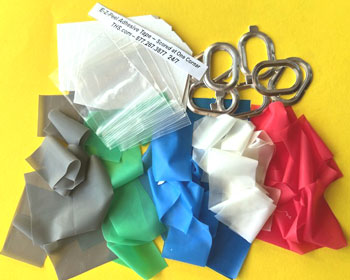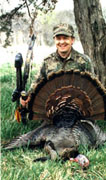Calling Strategy
Copyright © 1998 - 2021 Roger
W. Raisch * Nadine Adele, all rights reserved
|
You can't overcall a
flock of separated young turkeys in the fall unless they have been heavily hunted or it is
late in the year. My advice is to try to imitate
exactly what you hear the turkeys doing as they regroup, but do it in a more frantic and
distressed manner. For example, if a single lost pout starts to kee-kee, try to answer with the same call in
a similar tone, pitch and rhythm, but put more feeling in your calling. You should
answer every call you hear in the fall. Don't worry about calling mistakes, just
keep right on calling.
|
Talking To Young
Poults
|
Early in the fall a
young hen will make fast, high-pitched kee-kees (3 to 5 whistles) when she is lonesome and
trying to find another turkey. Later in the fall she will begin to replace the kee-kees
with yelping. Clucking is also a common call made by
young hens. Turkeys can not be depended on to act in a predictable manner at all
times. I believe that brood hens make a variation of the kee-kee-run, but with only
one or two whistles followed by several coarse yelps. This call is frequently heard
in the fall and is easily mistaken for the young jake's four-note kee-kee-run.
|
Young jakes will
make a slower, coarser four-note kee-kee or kee-kee run as well as coarse clucks and
gobbles when regrouping. Some jakes like to gobble a
lot and will start their gobble with one or two coarse kee-kees followed by a short,
choppy, high-pitched gobble.
|
All ages and sexes
of fall turkeys frequently make single or double yelps, particularly late in the year. A single yelp is difficult to do
with a mouth call so practice with your caller until you can duplicate this most effective
call.
|
Problems With
Mother
|
Many times you will
be carrying on a frantic conversation with one or more lost poults only to be interrupted
by a monotonous and continuous series of clucks, cutts or
coarse yelps. These
repetitious strings of up to 15 notes will be coming from the brood hen and is her
assembly call to regroup her poults. She won't have to
do it for long either. Her poults know her voice and all of them will quickly pass
you by in favor of her.
|
The moment you hear
this type of calling you need to decide what action you will take, if any. One choice is to simply stay where you are and compete with her
calling. You should duplicate her calls, but with more feeling and volume.
This is a good tactic if she is fairly close to you, say no more than 50 yards away.
Chances are fair that one of the young poults will pass your position en route to
mother. She does provide you with the proper calls and is a good live decoy.
|
Normally your best
choice is to run her off. Most of the time her poults
will go directly to her quickly and she will lead them away. All of this may take
only 10 to 15 minutes. If you allow her to call for more than
five minutes, chances of luring a turkey to your location are poor. During the process of running her off it is best not to scream and
yell to alert the other turkeys to your presence. Your noise while running or
walking in the leaves will not unduly alarm them.
|
Calling A Flock
|
A good way to lure
the flock to you, or to use as the flock is beginning to regroup, is to imitate the sounds
of several different birds getting together. The sounds
of an assembling flock are fairly easy to duplicate if you use a mouth call and some type
of friction call. Make a few lonely kee-kees, or
kee-kee-runs, and then answer yourself with old hen assembly yelps and clucks. If
you have talkative young jakes and they are gobbling, throw in a few assembly gobbles and coarse kee-kee-runs.
There is no secret sequence of calls, just mix it up like a real flock does.
|
Calling
18-Month-Old Gobblers
|
Eighteen-month-old
gobblers are fun to hunt. Although they are nearly two
years old, they will often call a lot when regrouping. They will yelp slowly and coarsely, no more than 4 to 6
yelps at one time. Very deep clucks and occasional gobbles are also typical. Once in a while one of them will gobble almost as
much as he will during the following spring. If one starts to gobble a lot, you can
repeat gobble for gobble his
calling, or if you can't duplicate a gobble, come back with slow
coarse yelps, and kee-kee runs. It is a strange blend of two kee-kee-runs as follows: kee-kee-kee-yelp-yelp-yelp-kee-kee-kee-yelp-yelp. The number of whistles and yelps will vary,
but the call will be run together into a single series of notes. |
| |
|











